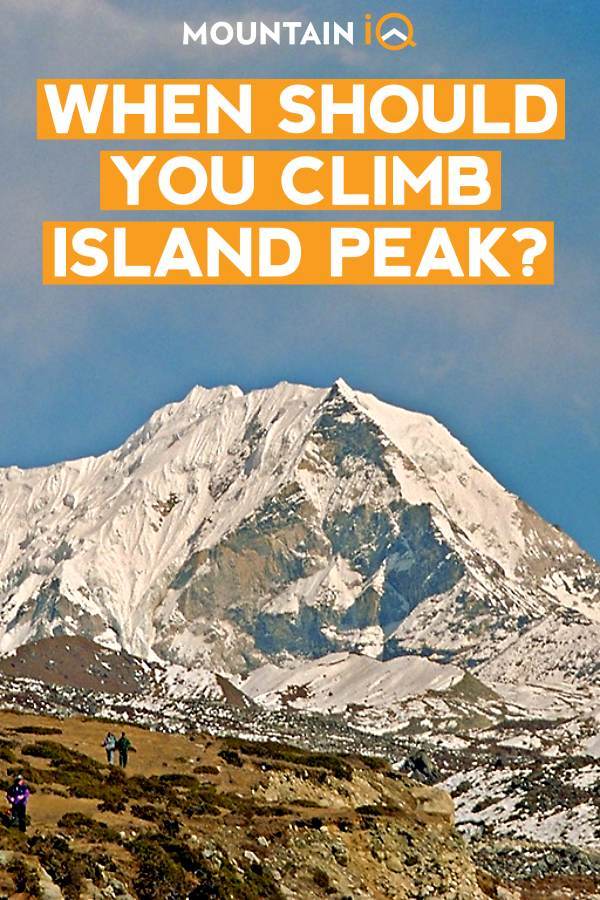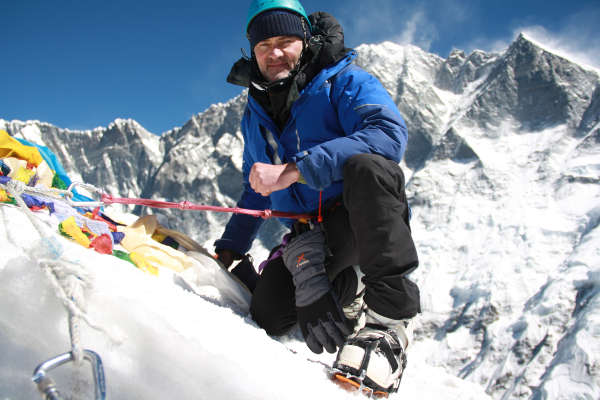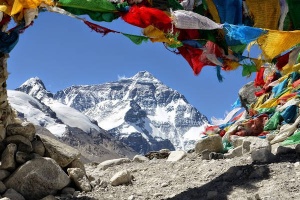As one of Nepal’s trekking peaks, the Island Peak climb can be done as a standalone expedition or an extension to the Everest Base Camp hike. A registered and experienced Sherpa guide is recommended. While you are not made to take porters, you will most likely want one too.
Here's my guide to climbing Island Peak based on my experience on the mountain.
You may also like my interview with Alan Arnette about Island Peak.
Climbing Island Peak
At 20,305 feet high, Island Peak or what the Nepalese know as Imja Tse is not one of the Himalayan giants but does provide a mountaineering experience that is exhilarating.
The climb itself is relatively straightforward. Angles on the headwall are mostly low, with one significant exception being a long section of 40 to 50 degree snow which will necessitate a fixed line. Some knowledge of rope work and technical climbing is required, but not significant experience. You can be informed of everything you need to know in the course of the trek – cows’ tails, jumars, fig 8s and screwgates.
The rate of elevation throughout the trek makes altitude sickness a potential risk.
Perhaps, like Sir Edmund Hillary, this trek will prepare you to climb Mount Everest. In fact, if you decided to climb Island Peak in April you will likely be on the mountain with people who are climbing Everest later in the season.
Island Peak was so named in 1952 by Eric Shipton’s party because they thought it resembled an island in a sea of ice.
The Island Peak expedition usually takes about 19 days, including hiking to Everest Base Camp (EBC).
Where is Island Peak?
Island Peak is in the Khumbu region (see the orange square on the map below). The mountain is part of Lhotse’s southern peak and is situated between Lhotse and Imja glaciers, not far from Mount Everest itself. Island Peak is accessed from the Imja Khola Valley, which runs adjacent to the Khumbu valley.
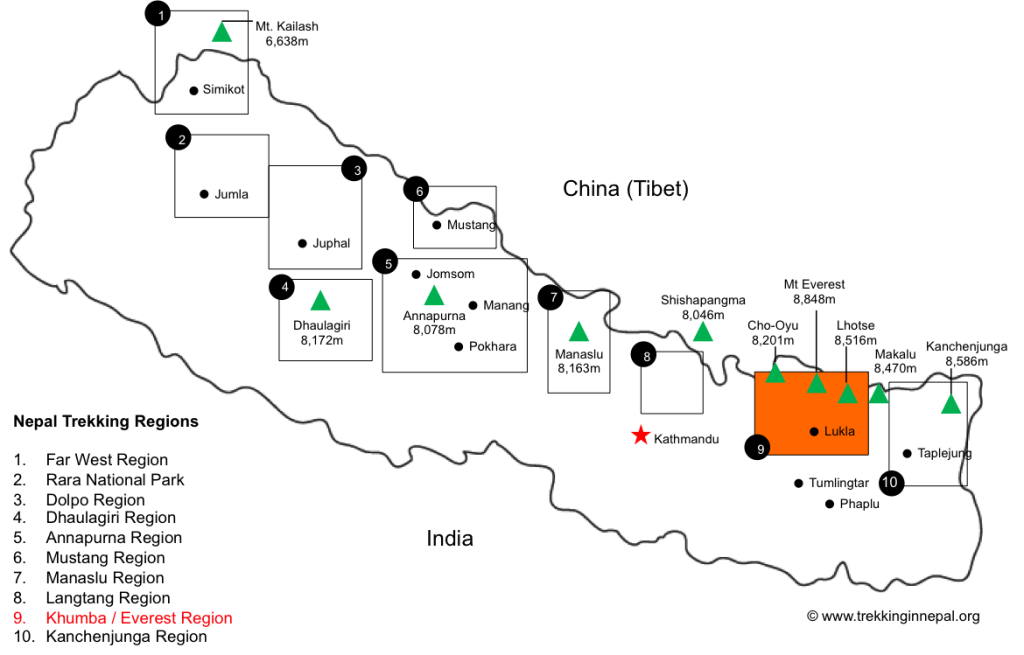
Is there a map for the region around Island Peak?
Yes, I recommend the following maps for the Island Peak Trek:
- Island Peak/Mera Peak 1:25,000 Climbing and Trekking Map
by Sandra Greulich and Sacha Wettstein - Island Peak Climbing Map – Imja Tse by Nepa Maps
What does the Island Peak climb itinerary look like?
Except for Island Peak Base Camp and the climb segment if you stay at High Camp, you will be staying in tea houses along the route for the rest of the time. Please note that there are several Island Peak trek itineraries that can be done.
Below we have laid out the most popular version – 19 days, leaving from Kathmandu. If you want to make your own way to Lukla, then you could probably organize this with your Nepal trekking company or guide.
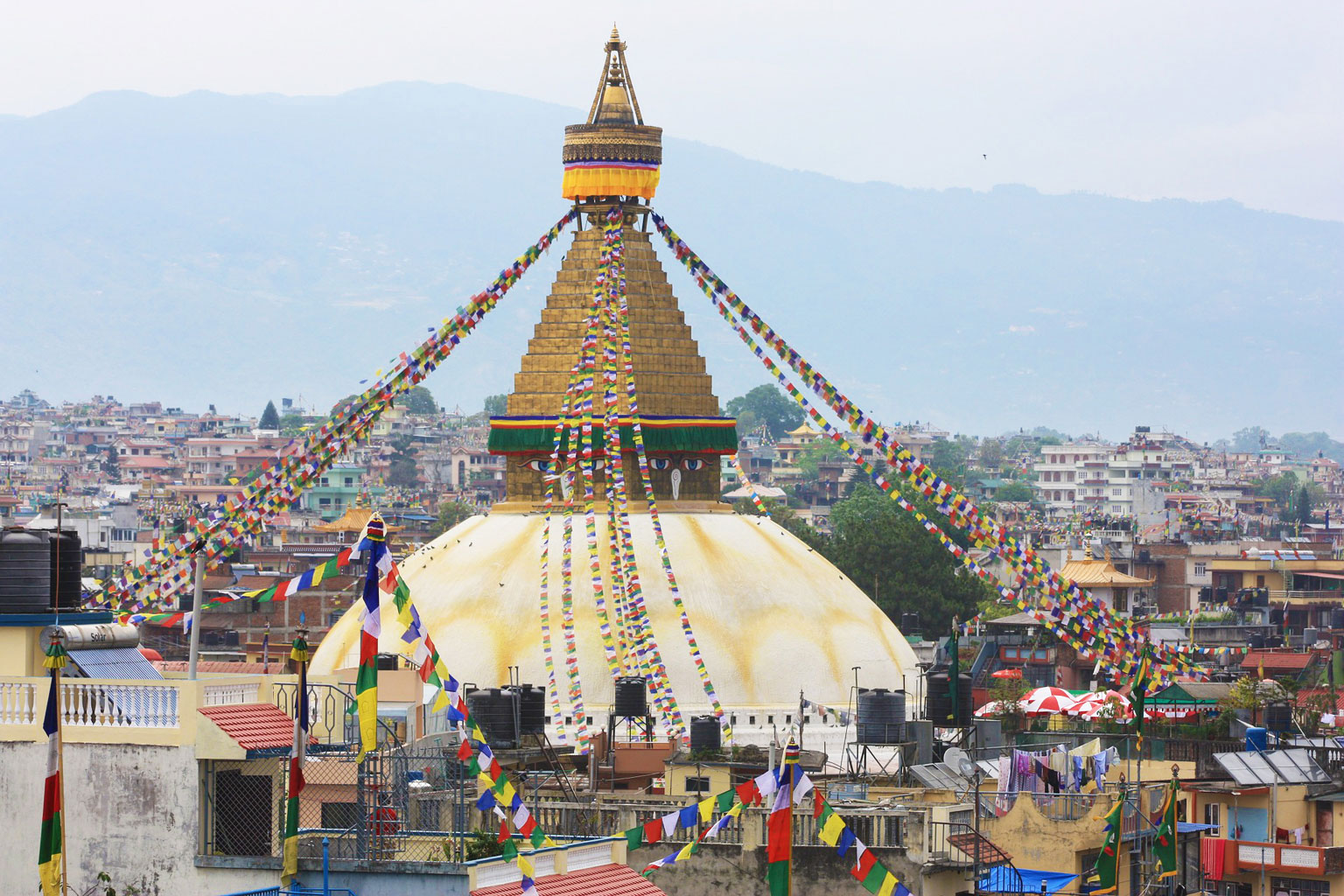
Day 1-2: Kathmandu
You will arrive Kathmandu on your first day. Your second day can be used to explore Kathmandu as your trek is prepared. The city is a UNESCO World Heritage Site and has loads of great Nepalese cultural sites to visit.
Day 3: Kathmandu to Lukla to Phakding
The 45-minute flight to Lukla offers sensational views of the Himalayas. You have a couple of hours to yourself before your trek begins. You will then hike to the village of Phakding along the impressive Dudh Kosi river.
Day 4: Phakding to Namche Bazaar
The pace of the second day is rather more challenging. You will continue to follow the Dudh Kosi river, passing through a beautiful forest. If the weather is good, you will get your first sight of Everest here. There is also a variety of plants and wildlife to look out for. After several hours of fairly steep climbing, you will arrive at Namche Bazaar, the heart of the Sherpa community and entrance to Sagarmatha National Park.

Day 5: Namche Bazaar
The fifth day is spent acclimatizing. This gives you with the opportunity to explore the delectations of this vibrant and prosperous village: a visit to the Sherpa Culture Museum or Mount Everest Documentation Centre with some time devoted to the local cafés, markets and shops. The Everest View Hotel above the village provides a great view of Everest and the other Khumbu peak. The hotel is also noteworthy for being the highest in the world!
Day 6: Namche Bazaar to Tengboche
This day is pleasant, taking in the beauty of fir, pine and rhododendron forest as you head for Tengboche. The monastery there is hugely significant to the Buddhist mountain people and is a great place to visit – it is well worth your time. You will see a 20-foot sculpture of Buddha, lama robes, musical instruments and ornate wall hangings. A prayer ceremony can be observed.
Day 7: Tengboche to Dingboche
The trek to Dingboche entails a number of gradual climbs with remarkable mountain views. You pass through birch, fir, juniper and rhododendron forest in addition to some open hillside. From Dingboche, Island Peak can be seen, along with many other stunning mountains. Be sure not to miss the French bakery in Dingboche.
Day 8: Dingboche
You will do more acclimatisation again on this day.
Day 9: Pheriche Valley to Lobuche
The challenge deepens today, commencing with a steep ascent to the ridge over the Pheriche Valley. Views are dramatic, encompassing peaks and snowfields in both Nepal and Tibet. Later on, at Tukla, you will advance past memorials dedicated to the Climbers and Sherpas who have perished on Everest in the last half century.
This is where you can see the memorial to Scott Fischer, the famous American guide and founder of Mountain Madness, who sadly perished on Everest during the 1996 tragic climbing season. You will end the day at Lobuche; just south of the village, you will see the peak of Lobuche East, another popular trekking peak in Nepal.
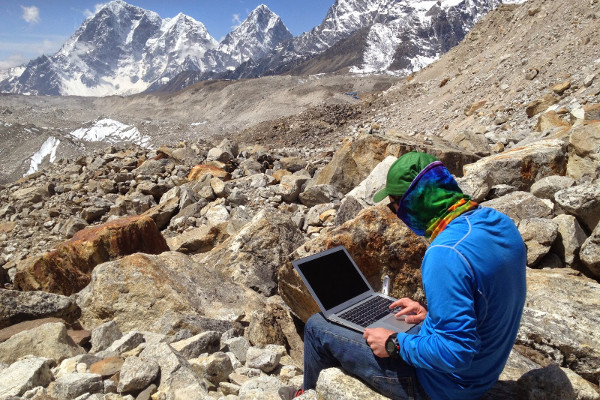
Day 10: Lobuche to Gorak Shep
Today, you will trek from Lobuche to Gorak Shep. Depending on time you can climb to Kala Patthar (5,643m) to get the finest view of Everest in the region. You can also see uninterrupted views of Changtse, Khumbutse, Lingtren and Pumori. These views will stay with you forever. You will stay overnight in Gorak Shep (5,164m).
Day 11: Everest Base Camp
Today, you will wake early to either trek up Kala Patthar, if you didn’t get a chance yesterday, or trek for two hours to Everest Base Camp. Most people return to Lobuche for the night.
Day 12-15: Island Peak Climb
See the detailed Climb Section below.
Day 16-19: Return to Kathmandu via Chukkung, Dingboche and Lukla
After you have completed your Island Peak climb and returned to Chukkung (see The Climb section below), you will then trek back to Dingboche where you will overnight again. From Dingboche, it is possible to trek all the way back to Namche Bazaar for another night and then onto Lukla to catch a flight back to Kathmandu. You may want to break up this return leg with another stop in Monjo or Phakding.
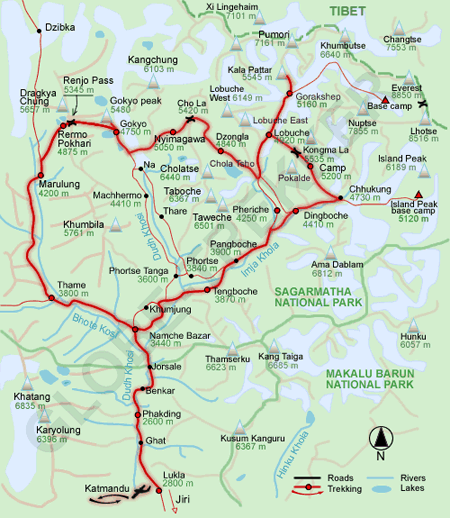
The Island Peak Climb
As mentioned in the itinerary above, the climbing segment of the Island Peak trek begins around day 12 and ends on day 15.
From Lobuche, there are two ways to get to the Imja Khola Valley – the first and easiest (but longest) is to trek back to Dingboche (overnight) and then head for the small settlement of Chukhung. The views are tremendous along the path. The second is to cross the Kongma La Pass (5,535m), which will get you to Chukhung on the same day but is of course a tough slog! See are article on Himalayan passes.
See the map above to get your bearings.
Chukhung (4,730m) consists of two teahouses, both are well equipped and serve awesome food! You can rent technical equipment, like crampons, hard sole boots, a harness, jumar, ice axes and helmets in Chukhung.
The hike from Chukhung to Island Peak Base Camp (5,087m) takes about 3-4 hours. Base camp is cut off from a fresh water supply (the nearest water is about an hour walk back down the valley). You will camp at base camp and prepare for the summit push.
Base Camp vs. High Camp
The push from Island Peak Base Camp to the summit is about 2 hours longer than the push from High Camp. It definitely makes the summit push easier if you leave from high camp (~5,300m) than from base camp, but you will need water supplies and porters to carry tents up to high camp to make this possible.
Assuming you leave for the summit from base camp, you will follow a gradual path for about 30 minutes. Just past the Imja Tse lake you will start to climb a relatively steep gravel and rocky path to High Camp (+- 1.5 hours). From high camp you continue up a rocky gully, that is usually icy in the early hours of the morning until you reach the crampon point. This is where you will get your first glimpses of the headwall and summit ridge of Island Peak, although it might not be light out yet.
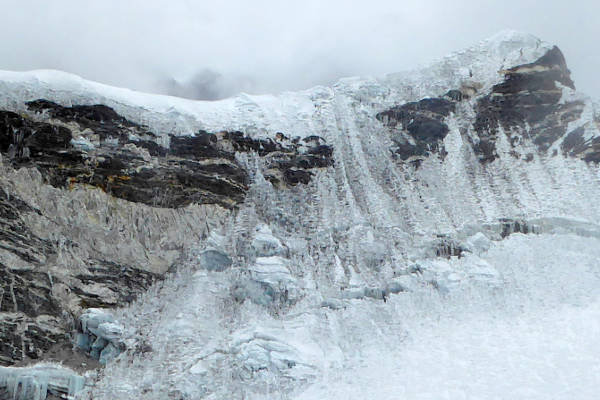
Please Note: Since the 2015 Earthquake, the glacier that leads up to Island Peak has fragmented in places. As of 2016, there are two large, exposed crevasses that require ladder crossings (see the picture below of one of the ladder crossings). These crevasses may have closed in recent times or more crevasses may have opened up. You should be prepared for sections of the glacier that require ladders to cross.
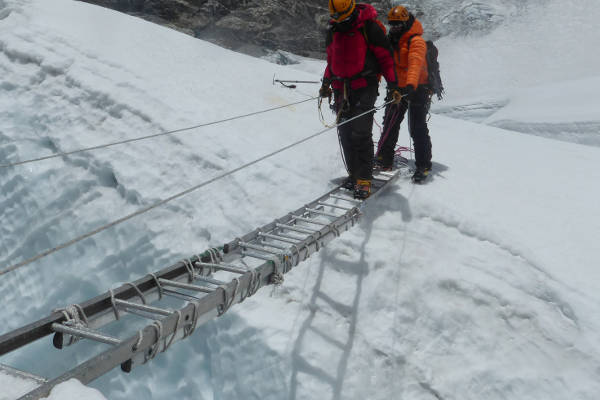
Once you have crossed the glacier and reached the headwall the first this you will notice that the ice on the wall has broken and fragmented a lot, partly due to the 2015 Earthquake but more to do with advancing climate change.
Below are a few pictures of the headwall as of 2016.
The wall is about 120m of vertical ascent at 40-50 degrees, with sections that have 70-80 degree steps. If you have not used a ascender or jumar it is worth undertaking a basic winter mountaineering course before joining an Island Peak expedition.
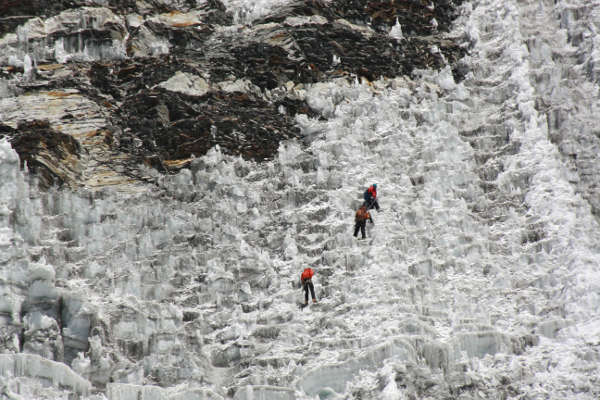
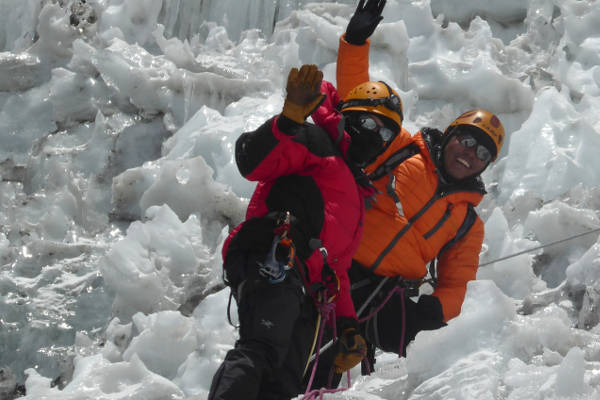
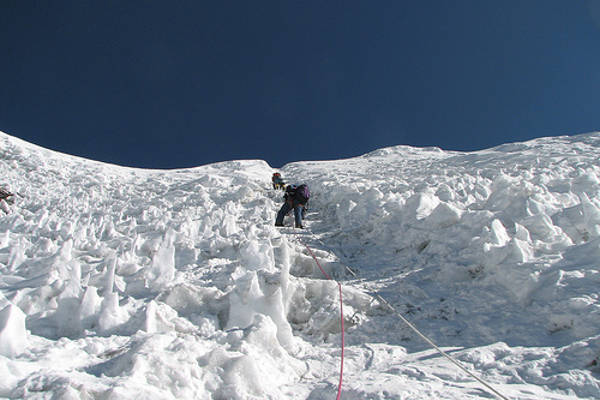
After navigating up the headwall, then all that is left is the knife-edged ridge to the summit.
In the past, it was common for climbers to walk along the narrow ridge to the summit, but because of the fragmentation on the mountain face, it is now easier and safer to traverse along the ridge to the summit.
You can see the traverse path in the picture below. The summit itself is about the size of a large round dining table. You can comfortably get 4-6 people onto the summit at a time.
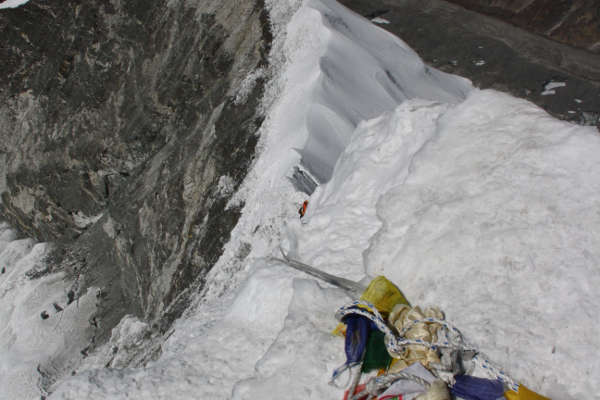
From the summit, the descent back to Base Camp takes about 5 hours. Be careful going down the headwall and on the glacier as that is where most mistakes happen!
More Island Peak Climb FAQs
When is the best time to trek Island Peak?
The best times to trek Island Peak are March to May and September to November.
How much does the Island Peak Trek cost?
Costs vary for the Island Peak climb, but for a good Western operator, you can expect to pay around $3,500.
Are permits required for the Island Peak climb?
Yes, permits are required for the Island Peak trek.
Island Peak is a Group B trekking peak, so a permit costing ~$350 for up to four people is required. A permit is also needed for Sagarmatha National Park. A $250 deposit ensures that garbage regulations are adhered to. A Trekkers Information Management System card is another necessity.
Be careful with insurance though; some companies cover you for hiking but not mountaineering (see our recommendations below).
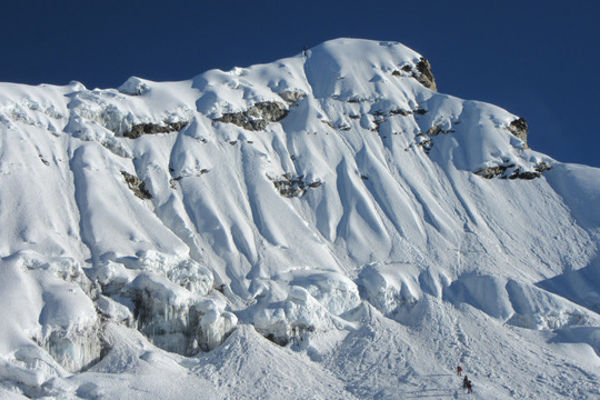
How difficult is the Island Peak climb?
It is generally regarded as one of the easiest trekking peaks, but don't be fooled, Island Peak is a serious challenge that involves a glacier crossing and ice climb up a steep headwall. Having completed the climb back in 2016, I can assure readers that the climb up Island Peak is not a ‘trek’! According to statistics I could gather from the Nepal Mountaineering Association, Island Peak lures in more than a thousand “trekkers” a year.
You will need a very good level of fitness and some experience with crampons and ice axes. Although trekkers do turn up with zero experience, this is not recommended. The summit bid is both long and exhausting if you are new to mountaineering.
Read The Climb section above to see what you will be getting yourself into.
Is altitude sickness a risk on the Island Peak Trek?
Yes, there is a risk of altitude sickness on the Island Peak Trek because it ascends to some high-altitude points. At its highest point, Island Peak, you will reach an altitude of 6,189 meters (20,305 feet). There are steep sections on this trek where you will ascend very rapidly.
Therefore, it is very important to have a clear understanding of the risks associated with high altitude trekking and how your acclimatises to high altitude. We recommend you read our detailed article on altitude sickness.
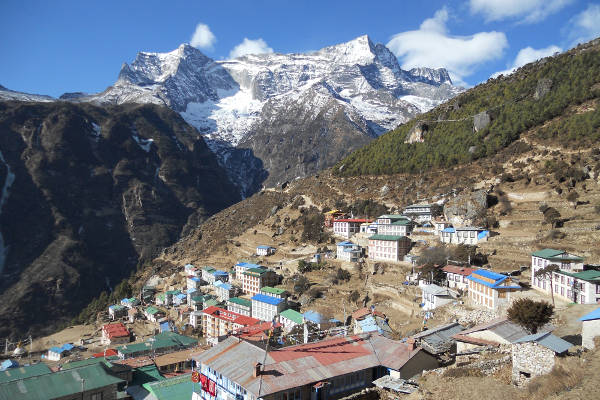
What gear do I need for the Island Peak Trek?
You need a number of essential pieces of trekking gear and some climbing gear for the Island Peak Trek.
Much of your gear can be rented or bought in Kathmandu. You can also rent important climbing gear in Chukkung (the last village before Island Peak Base Camp), but we strongly suggest bringing the most important pieces of gear and equipment with you.
For more packing lists, see our Resources page, as well as detailed gear reviews.
What kind of insurance do I need for the Island Peak trek?
Trekking insurance is vital in Nepal. This is particularly true on Island Peak where the risk of incident is higher than a standard trek. If an accident should occur that requires medical assistance and evacuation, you will certainly want proper trekking insurance that can cover the costs of air ambulance and treatment.
Make sure to have insurance that covers you for any travel related risks, like lost, damaged, stolen or delayed baggage; flight delays and interruptions; and tour operators default.
This article on Nepal hiking insurance provides great information on what type of insurance you need.
Please Note: Island Peak is classified as mountaineering and goes over 6000m in altitude, so most insurance companies will not cover you. The few that we do recommend are Snowcard, Dogtag or your national mountaineering association like the BMC in the UK or the American Alpine Club in the States.
Are there any recommended guidebooks for the Island Peak Trek?
Sadly, there are no dedicated guidebooks for Island Peak, but Islands in the Snow, a mountain diary by Mark Horrell, is excellent and very entertaining.
Are there other Nepal trekking routes?
Yes, there are other Nepal trekking routes you can try. If the Island Peak Trek isn't your cup of tea, then you could always try your hand at the Everest Base Camp Trek, the Langtang Valley Trek or the Manaslu Circuit Trek, which are considered some of the best hikes in Nepal.
Continue browsing
See more information on Nepal. Or check out these other Nepal hiking articles:
